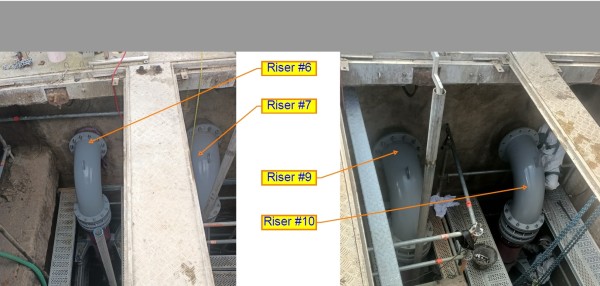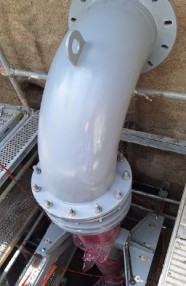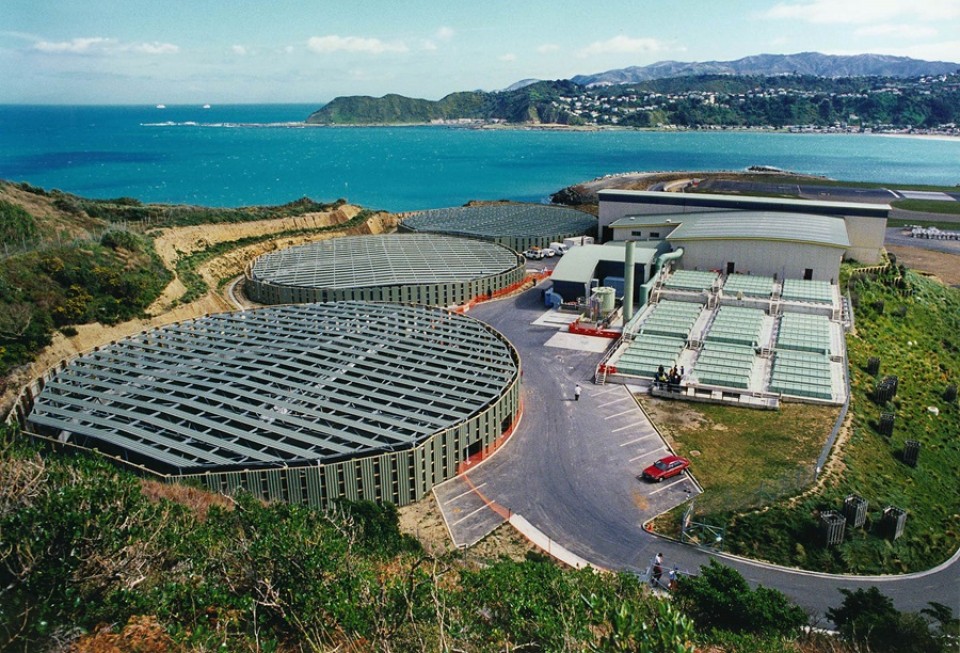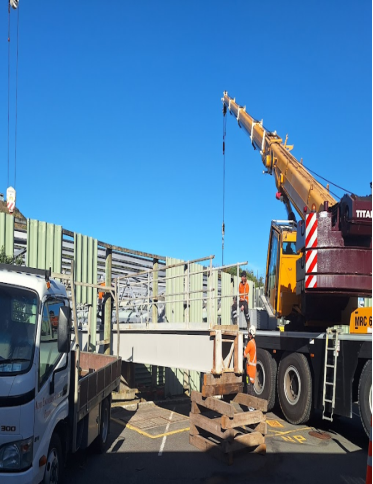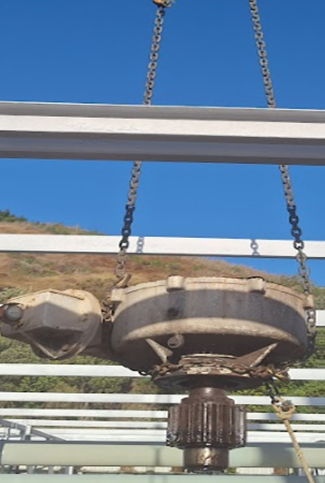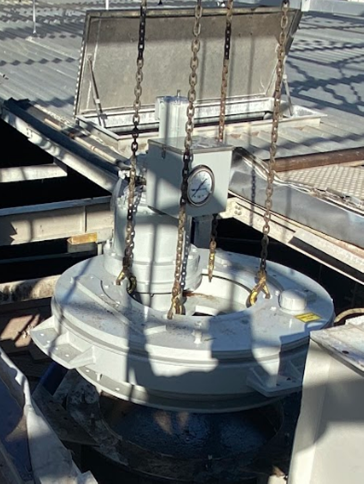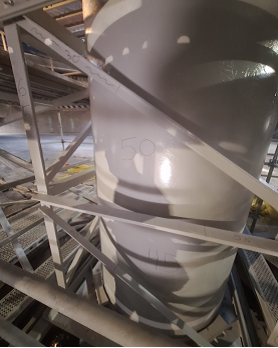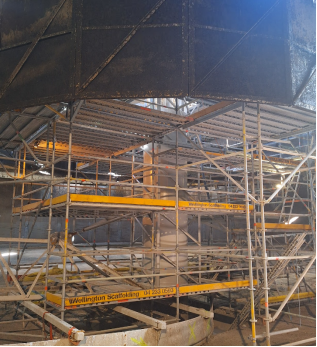Moa Point wastewater treatment plant refurbishment projects
We're refurbishing the Moa Point wastewater treatment plant on behalf of Wellington City Council to improve the performance and efficiency of the plant and reduce the risk of discharges. Click the background tab to find out more.
If you have any questions about this work, please contact:
Wellington Water, 04 912 4400
Latest Updates
The refurbishment of the third and final clarifier reached a key milestone last week - the team successfully lifted and installed the replacement main drive bearing, a key major technical component of the clarifier.
The final phase of the Inlet Pump Station renewal project, to replace the last four of 10 riser pipes, has been completed ahead of schedule.
Work is currently underway with refurbishment of the third and final clarifier at the Moa Point Wastewater Treatment Plant.
Inlet pump station and clarifier refurbishment
Works on the first phase of the refurbishment to replace four of the 10 riser pipes in the Inlet Pump Station were completed in November 2023. We reached another milestone in May 2024 with the second phase installing a further two new riser pipes in the adjacent wet well. The third and final phase of work to install the remaining four riser pipes commenced on 14 October 2024 and weather permitting, we expect to complete this by the end of February.
We have completed the mechanical refurbishment of two out of three clarifiers. Work to refurbish the last clarifier will commence on 21 October 2024 and expected to be completed by the end of November 2024.
Further work to replace the main drive bearing of Clarifier 1 will be done following completion of this maintenance. This is a continuation of our programme of upgrade and refurbishment to the plant which was paused over the winter period.
Please see the Updates tab for more detailed information on the progress of the works.
Aeration system renewal design
Design work is underway for the renewal of the aeration system. Cost and timing for the upgrade will not be determined until the concept design is complete. Find out more on the ‘background’ page.
Why is this work needed?
The Moa Point Wastewater Treatment Plant cleans and disinfects wastewater from about 180,000 people every day. Find out more about Moa Point’s operations here
Much of the plant’s equipment and parts are nearing the end of their service life, which means its more prone to service interruptions and needs more maintenance.
A multi-million-dollar programme of work is planned over the next seven years to renew and upgrade equipment at the plant to improve its operation, subject to funding being confirmed. This programme includes improving the reliability and effectiveness of the treatment, increasing capacity to handle population growth, and improving safety.
Find out more below about individual projects that are underway.
Sludge Management Facility
Wellington City Council is managing a project to build a new Sludge Management Facility.. Find out more on the Wellington City Council website here
Inlet pump station
The inlet pump station refurbishment is replacing and repairing parts that are nearing the end of their design life.
This will increase the resilience of the pump station and improve environmental and health outcomes by reducing the risk and frequency of discharges through the short outfall into the environment.
The long-term plan is to replace all 10 risers and pumps in a phased programme that will restore the plant’s design pumping capacity of 4,000 litres per second. The programme is expected to take between 12 and 18 months to complete.
The work is being done in phases , so that some risers will remain operational at all times to reduce the risk of discharges to the environment while the work is underway.
Clarifier refurbishment
The Moa Point wastewater treatment plant has three clarifiers. These are large tanks that are used to separate the large clusters of bacteria called sludge from the treated wastewater through gravity.
We are replacing mechanical components that are at the end of life. The work is being undertaken proactively to avoid plant failure which would cause unconsented discharges from the treatment plant. We are taking a phased approach, having one clarifier offline for refurbishment at a time. Taking a clarifier offline temporarily reduces the plant’s capacity from 3,009 L/s to approximately 2,000 L/s. That is why we are doing this work during summer to autumn when there are lower flows.
We are confident the plant will be able to treat dry weather flow levels with the remaining two clarifiers. However, the reduction in treatment capacity does increase the risk of unconsented discharges of partially treated wastewater at the long outfall during periods of high rainfall although this risk is assessed as low overall compared to undertaking the work during winter.
Emptying and cleaning the clarifier will involve removing some sludge, which may cause a very low amount of odour, but it will only be for a short period.
This work is due to be completed by June 2024.
Wellington Water will provide regular updates regarding this project.
Aeration system renewal
Planning is getting underway to replace the blowers that deliver the oxygen essential to the biological treatment process.
In the biological treatment process (secondary treatment) bacteria break down organic matter in the wastewater. The bacteria need a supply of oxygen and the right temperature range to thrive.
Currently the blowers that aerate the process at the Moa Point Wastewater Treatment Plant are 25 years old, and nearing the end of their expected, useful mechanical life. They are currently located in a room below ground, in the main building. The room is poorly ventilated and the air drawn into the blowers is hot, particularly during summer. This causes operational challenges in maintaining the temperature range for the biological process. These blowers are also extremely noisy, creating undesirable working conditions.
In 2024-25 we are looking at options for equipment and location. Cost and timing for the upgrade will not be determined until the concept design is complete.
All Updates
The refurbishment of the third and final clarifier reached a key milestone last week.
The team successfully lifted and installed the replacement main drive bearing, a key major technical component of the clarifier.
With this installation completed there are some further remedial works remaining inside the clarifier such as replacement of any corroded nuts and bolts as well as other mechanical components. This is expected to take approximately 12 weeks before the clarifier is able to be brought back into operation.
The final phase of the Inlet Pump Station renewal project, to replace the last four of 10 riser pipes, has been completed ahead of schedule.
This means that all 10 riser pipes, and pumps, are now in operation across both wet wells restoring the plant’s design pumping capacity of at least 4,000 L/s and addresses the risk of untreated discharges to the environment during heavy rainfall.
As part of this work, four of the pumps have been replaced with new pumps (images below) with a further four pumps scheduled for replacement in the second half of the year.
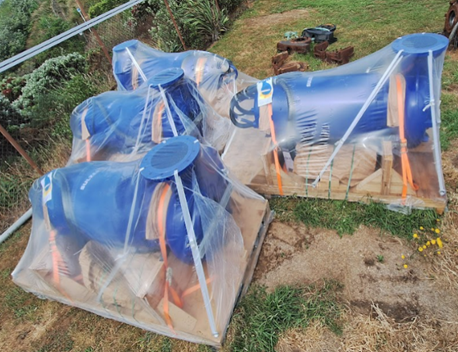
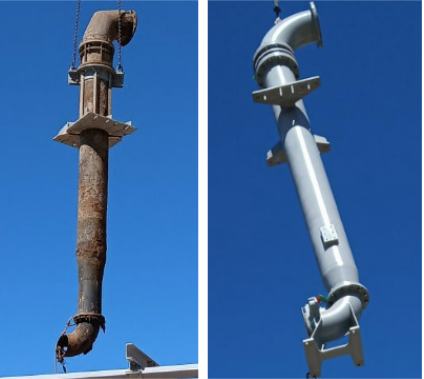
Four new pumps prior to installation Old riser replaced by a new riser
Thank you for your patience and understanding whilst this work has been carried out.
Work is currently underway with refurbishment of the third and final clarifier at the Moa Point Wastewater Treatment Plant. The clarifiers are large tanks used to separate sludge from treated wastewater. Refurbishment of two of the three clarifiers has been completed and the same process is being applied with the third.
Draining, cleaning and disinfection of Clarifier #1 in preparation for the refurbishment was completed prior to the Christmas break. This enabled the scaffolding to be erected soon after so a detailed inspection could take place this week.
The next stage of work will be the remedial repairs identified in the inspection. This should start next week and is expected to take a couple of months before the team move on to refurbishing and replacing key mechanical components including the main drive bearing.
Following completion of this work the plant’s capacity will be restored, with all three clarifiers on track to return to service by end of June 2025.
These activities are vital to improve the operation of the plant, so it runs at optimal level. We thank you for your patience and understanding while we carried out this important maintenance work.’’
We will keep you informed as the project progresses.
The final phase of the Inlet Pump Station (IPS) renewal project to replace the last four of 10 riser pipers that began in October is progressing well.
The work has been split into two stages either side of Christmas with the first stage being three riser pipes replaced in the same wet well. Below are some images showing them in place.
The IPS pumping capacity is now around 3,800 L/s versus 3,100 L/s after completion of phase 2 of the project. This reduces the risk of untreated discharge during heavy rainfall over the holiday period.
Works will recommence in mid-January to replace the final riser which will require us to temporarily take the adjacent wet well offline and reducing the IPS capacity again during this period. The project is on track to be completed by end of March 2025.
We will keep you informed as the project progresses.
|
Riser pipe 1 installed |
Riser pipes 4 & 5 installed |
Heavily corroded old riser being lifted out |
Wellington Water, on behalf of Wellington City Council, is continuing its programme of maintenance and refurbishment of the clarifier tanks at the Council’s Moa Point Wastewater Treatment Plant. This is part of efforts to enhance the plant’s performance and safeguard the environment.
Media release - Moa Point Wastewater Treatment Plant refurbishment work underway
We are about to get underway with some planned maintenance on one of our three Clarifiers at the Moa Point Wastewater Treatment Plant (the plant). This work is scheduled to commence on 21 October 2024 and expected to be completed before the end of November 2024.
The maintenance activity is being undertaken in parallel with the works currently underway on the Inlet Pump Station (IPS). These activities will temporarily reduce the plant’s capacity, so we have scheduled this work to be done now, when there’s less water in the network. This minimises the risk of compromising the ongoing operation of the plant.
We are confident the plant will be able to treat dry weather flow levels with the remaining two clarifiers. However, the reduction in the IPS pumping capacity during the works does increase the risk of discharges of untreated wastewater at the short outfall during periods of high rainfall. As the plant can still fully treat the flow delivered by the IPS during the maintenance period with operation of two clarifiers, we have assessed the overall risk as low.
Emptying and cleaning the clarifier will involve removing some sludge, which may cause a very low amount of odour. We are aware that odour from the plant is a concern for residents, and we anticipate odour may be present for short periods of time while we undertake this work. We will do our best to complete this work as soon as possible to minimise impact on the community.
Planned maintenance activities are vital to improve operation of the plant. This work is part of an ongoing programme of work to improve performance of the plant, ensuring it operates at an optimal level.
We thank you for your patience and understanding while we carry out this important maintenance work.
Further work to refurbish the inlet pump station at the Moa Point Wastewater Treatment Plant will commence on 14 October. Weather permitting, we expect to be completed by the end of February 2025.
This is the third and final phase of a programme that will increase the resilience of the pump station and improve environmental and health outcomes by reducing the risk and frequency of discharges through the short outfall into the environment.
This final phase involves replacing the last four of 10 riser pipes at the pump station to help address the immediate risk of discharges to the environment. When completed, the pump capacity of the plant will be restored.
Some work may be undertaken at night to take advantage of lower volumes of wastewater during this time. We will notify residents of this in advance and efforts will be made to minimise noise impacts.
We are aware that odour from the pump station is a concern for residents. We anticipate odour may be present for short periods of time while we undertake this work. However, we plan to mitigate odour issues by having negative air pressure to draw in air when the pump station doors are open. The work site will also be screened off.
This project is not associated with current works underway at the treatment plant constructing the Sludge Minimisation Facility (SMF). However, it will coincide with the work the SMF project is currently doing on the inlet pump station to incorporate it into the facility.
Following refurbishment and bearing replacement work, Clarifier #2 at Moa Point WWTP is now fully operational and the plant has returned to its full treatment capacity.
Contractors have made excellent progress in June, finishing off the protective painting, replacing the main drive bearing and also refurbishing the other larger mechanical components within the structure.
|
Image 1. Crane used for removal and installation |
Image 2. Old drive lifted out |
Image 3. New drive lifted into position |
The final minor mechanical works are now taking place to ensure the clarifier is ready to run smoothly when it is brought back online. This is expected to be within the next couple of weeks.
We will advise you when the project has been completed.
The remedial works recommended in April’s specialist assessment are currently in progress with contractors replacing bolts and brackets that have been damaged from corrosion.
Another crucial part of these remedial works is to recoat areas like structural beams, cross bracing and other areas with specialist protective paint to help slow down corrosion in the future. This does take some time unfortunately due to the sheer size of the structure and the amount of areas identified for recoating. See Figures 1 & 2 below.
|
Figure 1: Centre column recoated |
Figure 2: Scaffolding around drive cage for recoating |
We expect this work to be completed within the next 2-3 weeks before the team can move on and carry out the main upgrade - replacing the bearing and other major mechanical components. The project is currently forecasted to be completed in early July to accommodate the recommended additional works from the specialist assessment.
We will keep you informed as the project progresses.
Works for the latest phase of the Inlet Pump Station project have been completed on schedule. This brings the total number of replaced riser pipes to six out of 10, significantly improving the reliability and resilience against short outfall discharges to the Coastal Marine environment.
Please note that further work is planned to complete the refurbishment and get the pump station back to full capacity and reliability.
We are planning to continue this work next summer when the flows to the treatment plant are low. This scheduling is to reduce the likelihood of untreated wastewater discharge during heavy rainfall.
The inspection of the clarifier has been successfully completed with the specialist engineers identifying some areas needed for additional remedial works.
Examples identified were corrosion around various bolts and brackets (Image 1) that help support the internal structure. These will be replaced along with other key steel structural supports that may require cleaning/recoating to protect against future corrosion (Images 2 & 3).
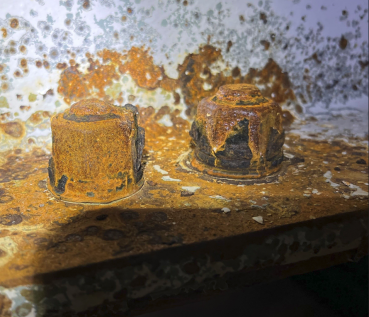
|
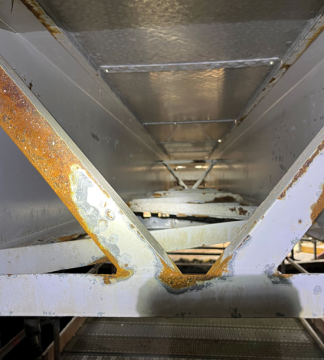
|
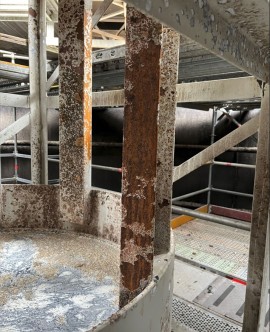
|
| Image 1 - Corroded bolts | Image 2 - Minor corrosion to support beams | Image 3 - Steel structure to be recoated |
These physical works are now underway and will precede the main upgrade to the key mechanical components of the clarifier in the coming weeks.
We will keep you informed as the project progresses.
Works are underway to clean the wet well at the Moa Point Inlet Pumping Station ahead of the 2 riser pipes replacement works in April. This may increase the level of odour around the pumping station whilst this cleaning is carried out.
The physical works to replace the riser pipes will begin on 3rd April. Once completed, this will bring the total to six out of the 10 riser pipes replaced, significantly improving reliability and resilience against short outfall discharges to the Coastal Marine environment.
The works involves taking one of the two wet wells offline throughout the duration of the project. We are confident that one wet well will be able to handle the dry weather flow going into the inlet pump station. However, the temporary reduction in the pump station’s discharge capacity does increase the risk of untreated wastewater overflows to the short outfall during a period of heavy rainfall. This project is being undertaken in parallel with the Moa Point Wastewater Treatment Plant clarifier refurbishment project to reduce the timeframe of the plant operating at reduced capacity. The Inlet Pumping Station project is expected to be completed in May 2024 with the clarifier works finishing in June 2024.
Should there be an overflow at any time during the Inlet Pumping Station project work, we will immediately notify the community as per the standard protocol.
In preparation for the second phase of the inlet pump station work that's coming up, we've provided residents with more information via the Resident letter - Moa Point Inlet Pump Station Phase 2 which was posted last week.
This work will commence at the end of March 2024 as part of a wider programme to refurbish the station. We'll keep you informed as the project progresses.
Contractors have completed the cleaning of the inside of the clarifier.
All the components are now ready to be structurally assessed by specialist engineers and these inspections are scheduled for next week, weather permitting.
After the inspections are completed, the team will begin the planned upgrade works to the main mechanical components of the clarifier and also any potential additional remedial works discovered through the inspections.
We will keep you informed as the project progresses.
Good progress has been made by the contractors who have been power washing the inside of the clarifier these past few weeks (see pic below).
This has enabled some extra scaffolding to be erected which will allow the contractors to access the areas that are inherently more difficult to clean.
Once this more detailed cleaning to expose steel and mechanical components is complete, the clarifier will then be ready to be structurally assessed by a specialist engineer. This inspection will hopefully take place around the beginning of March.
We will keep you informed as the project progresses.
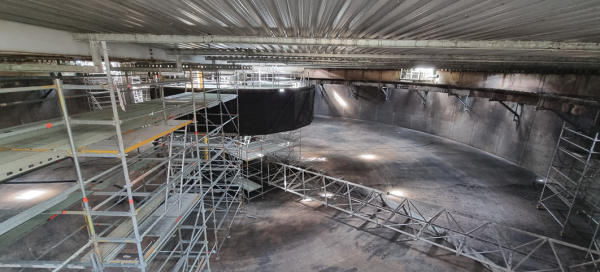
(Inside of Clarifier 2 post initial clean)
The team have drained down the clarifier last week.
This is the first stage of a large project that will see the inside of the clarifier cleaned, refurbished and re-painted before a full replacement of the central mechanical bearing that drives the scrapers around the structure. There is a chance this may cause minimal odour but it will only be for a short period.
This now enables the contractors to safely enter and begin power washing the whole inside of the clarifier. This process will begin this week and is expected to take around 3-4 weeks.
Once the cleaning is complete it allows a structural engineer to accurately assess the condition of the clarifier and identify any potential remedial works needed.
We will keep you informed as the project progresses.
Please be advised that the draining down of the clarifier has been rescheduled to next week, from the 23rd January 2024.
This extra period will be used by the operators to ensure the plant is in optimum condition to have the clarifier taken ‘offline’ ahead of the project.
Thank you for your patience and understanding.
From 15 January 2024 we will be starting work on refurbishing one of the three clarifiers.
This project is being undertaken in parallel with the replacement of the rising main pipes at the inlet pump station to shorten the time that the treatment plant’s capacity is reduced. It involves emptying and cleaning the clarifier and having it assessed internally by structural engineers. The team will then begin the process of installing the new main drive and bearings. Click on the background tab to find out more about the 'clarifier' project.
Emptying and cleaning the clarifier will involve removing some sludge, which may cause a very low amount of odour, but it will only be for a short period. We will provide further updates about the exact timing of this work.
We are delighted to inform that the 4 pumps were successfully reinstalled this week and the wet well was back brought back online from Tuesday - 3 days ahead of schedule!
Veolia have been monitoring the pumps performance closely over the last few days to make sure the desired performance, from both the pipes and pumps, is being achieved.
The next phase of works for Inlet Pumping Station will be to install 2 new riser pipes, just like the 4 installed this month, in the adjacent wet well. These works are expected to begin late March next year.
Last week’s work to fix the wall brackets and anchors was successful and we are pleased to report the riser pipes are now fixed in their positions, ready to be connected to their individual pumps.
The scaffolding within the wet well has been removed and the contractor brought in to install the riser pipes has now demobilized from site.
This week Veolia began the process of reinstalling the 4 pumps and this is expected to be finished by the end of the week.
We will provide another update next week and confirm the status of the project.
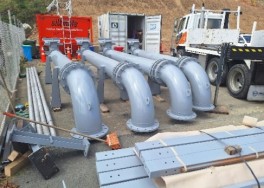 Works are progressing well at the inlet pump station with the 4 riser pipes now in position.
Works are progressing well at the inlet pump station with the 4 riser pipes now in position.
This week will see the installation of the wall brackets and anchors to keep the pipes fixed in their position as well as some minor grouting within the wet well.
Assuming this work goes to plan, we plan on lifting the 4 pumps back into their original positions the following week.
We will provide a further update when this week’s work has been completed.
